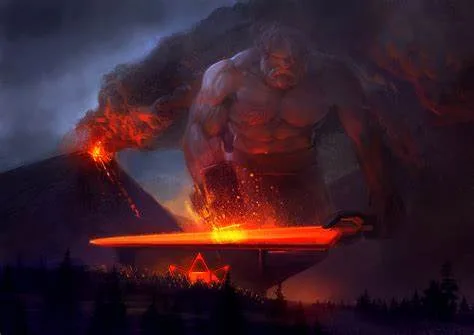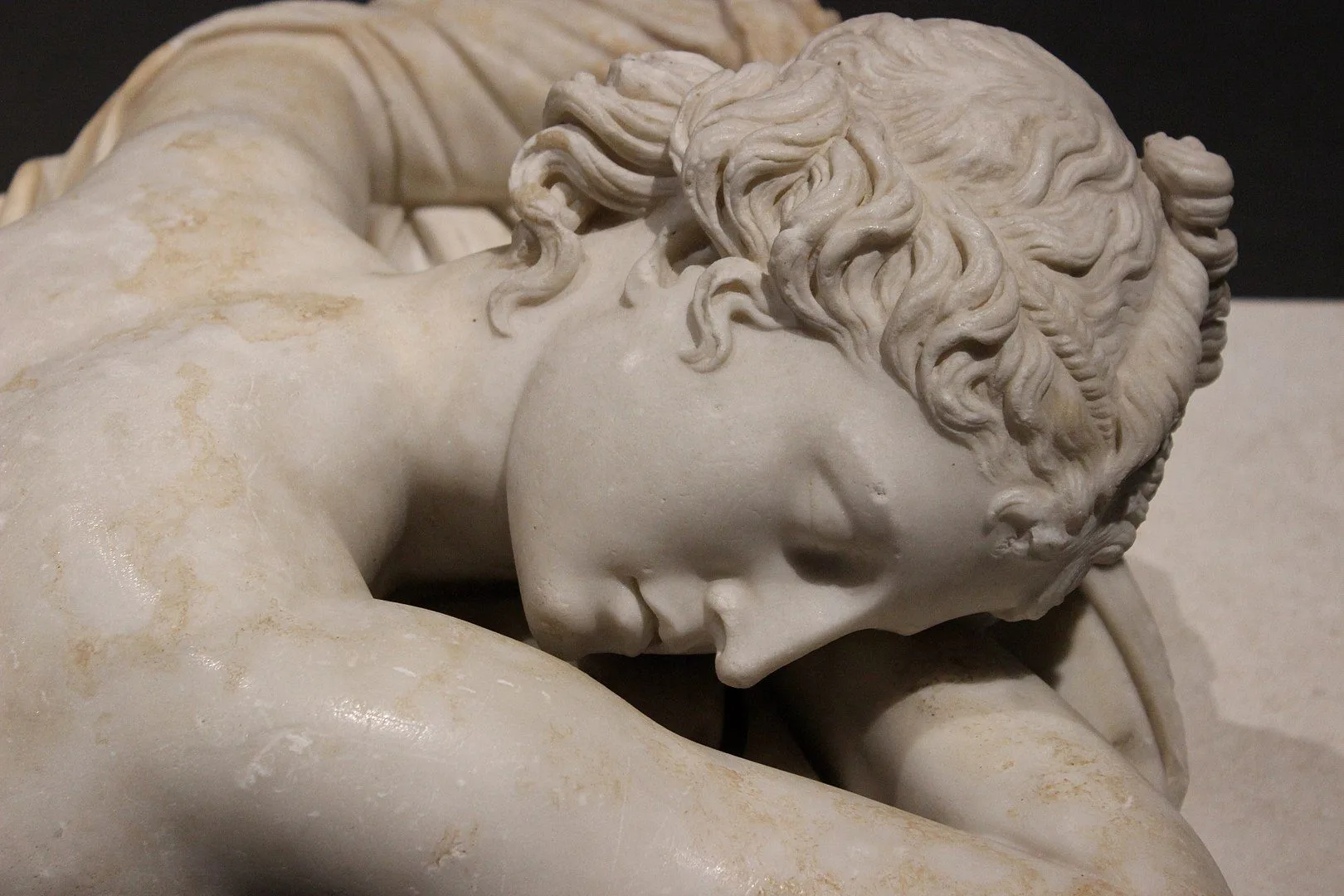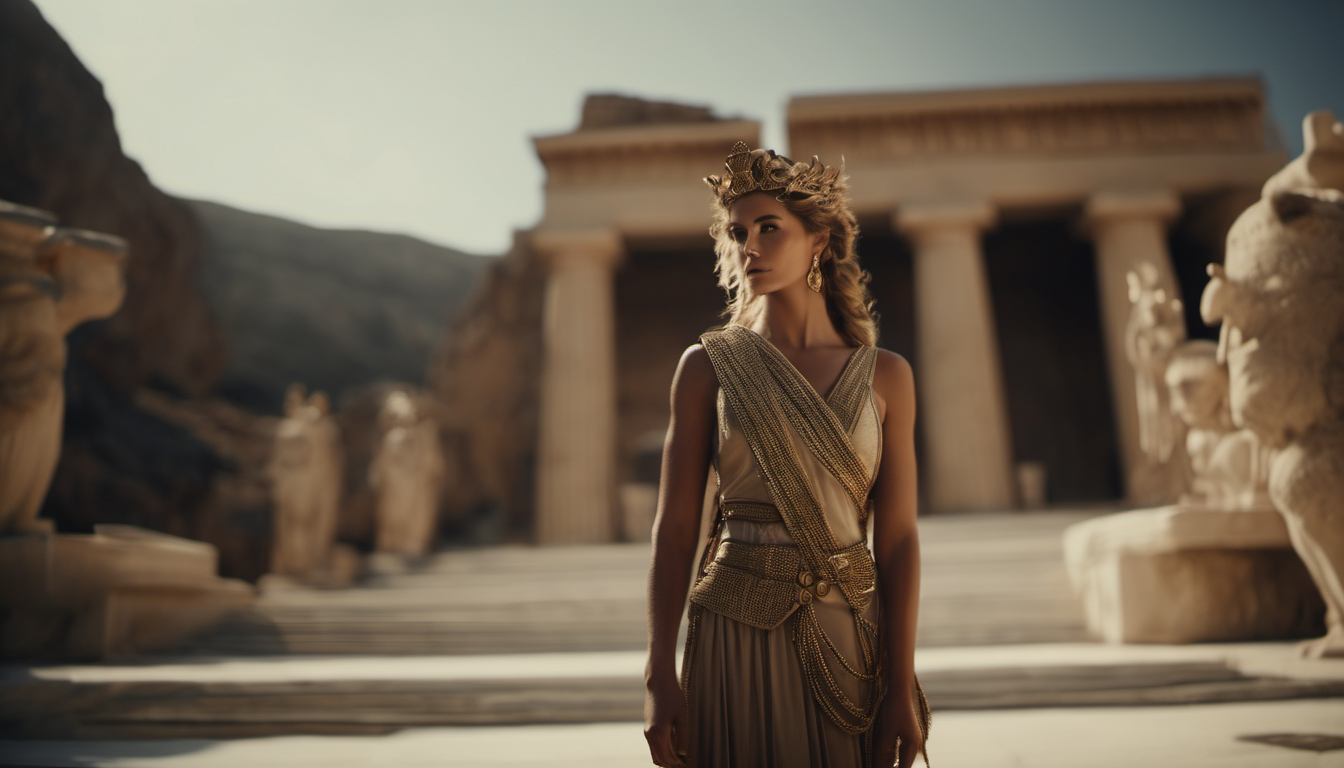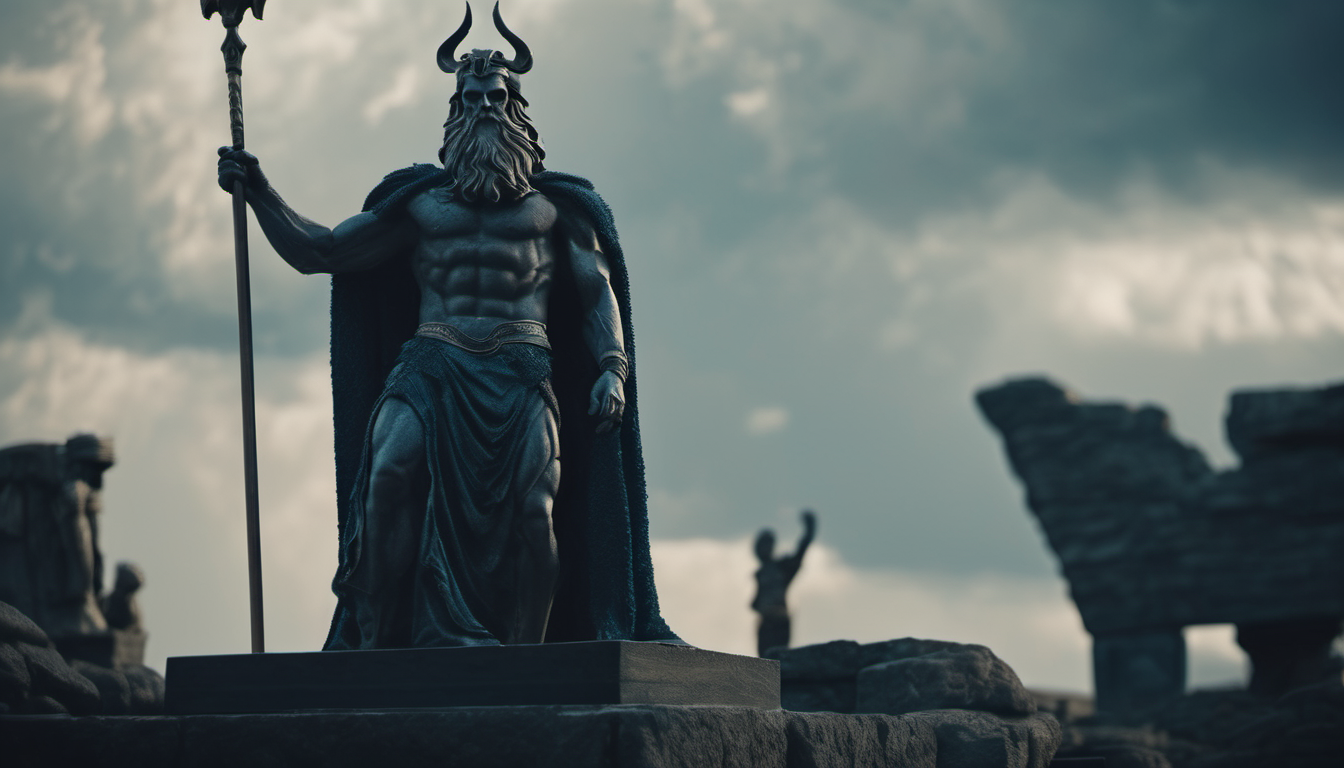Explore the Myth of Hephaestus, the Craftsman God
Contents
- 1 Hephaestus: The Greek God of Fire, Volcanoes, and Metalworking
- 1.1 Introduction to the Blacksmith God
- 1.2 The Mythical Origins and Family of Hephaestus
- 1.3 The God’s Purpose: Providing for Gods and Humans
- 1.4 Legends and Myths of Hephaestus, God of Volcanoes
- 1.5 The Appearance and Symbols of the Greek God
- 1.6 Hephaestus’ Workshops and Creations
- 1.7 Hephaestus’ Automatons and Mechanical Creations
- 1.8 Hephaestus in Ancient Greek Religion and Worship
- 1.9 Hephaestus in Greek Art and Literature
- 1.10 Interpretations and Comparative Mythology of Hephaestus
- 1.11 Conclusion
- 1.12 References
Hephaestus: The Greek God of Fire, Volcanoes, and Metalworking
Hephaestus was the Greek god of fire, metalworking, stone masonry, forges, and craftsmanship. With his hammer, anvil, and forge, he created powerful weapons and armor for gods and heroes. His Roman counterpart was Vulcan.
Introduction to the Blacksmith God
In Greek mythology, Hephaestus was a supporting god who served a vital purpose through his craftsmanship. As a skilled blacksmith and master of metallurgy, he forged magnificent works for the other Olympian gods and mankind. His creations were associated with high quality construction and divine artistry.
Hephaestus was worshipped in ancient Greek religion as the divine embodiment of fire and volcanoes. His origins tie him closely to the forces of nature and seismic activity. Myths depict him with crippled legs and a misshapen appearance, but he epitomized productive craftsmanship.
According to some legends, Hephaestus was associated with the dark smith powers of the primordial deities. His origins hark back to ancient notions of mystical blacksmithing that could produce wondrous objects imbued with magic. Hephaestus exemplified the archetype of the ingenious smith whose skill produced glory for the gods.
The Mythical Origins and Family of Hephaestus
There are a few variations on Hephaestus’ origins. The common thread is that he was born to the goddess Hera, either through parthenogenesis or by Zeus. One legend claims Hera bore Hephaestus alone in retaliation to Zeus giving birth to Athena without her. Another says Zeus was his father, but Hera tossed Hephaestus from Mount Olympus for being ugly and deformed. His resulting fall left him crippled.
Some myths say that Hephaestus was born weak and crippled, so an embarrassed Hera flung him from Olympus. Alternatively, he may have been born normal but later injured his legs falling from the heavens. In any case, these legends emphasize his deformity and tie his craft to compensation for his imperfections.
Though lame and disfigured, Hephaestus did not live a joyless existence. His workshop resounded with activity and creativity. He exemplified how disability did not preclude achievement. The god transformed his hardship into beautiful works benefitting immortals and mankind alike.
Hephaestus had a turbulent relationship with Hera as his mother. His marriage to the goddess Aphrodite was also rocky, as she cheated on him with other gods like Ares. Hephaestus had no true natural children, but he treated his mechanical creations like Daedalus and Talos as his offspring.
Family Members
- Parents: Hera and possibly Zeus
- Siblings: Ares, Eileithyia, Hebe, Enyo
- Wife: Aphrodite
- Children: Thalia, Eucleia, Euthenia, Eupheme, Philophrosyne (with Aglaea), Erichthonius of Athens (with Athena)
- Creations: Pandora, mechanical servants
Hephaestus’ origins from Hera explain his familial connections. But his lack of natural children speaks to his solitary habits perfecting works in isolation.
The God’s Purpose: Providing for Gods and Humans
As a blacksmithing god, Hephaestus served the important purpose of arming and outfitting the other Greek gods. His workshop furnished the gods with magnificent tools, weapons, armor, furnishings, and jewelry befitting immortals. The following creations exemplify Hephaestus’ skill:
- Intricate thrones – He fashioned majestic thrones for Hera, Zeus, Hades, and other gods. His throne for Hera could move on its own accord.
- Zeus’ lightning bolts – The mighty thunderbolts wielded by Zeus were forged by Hephaestus.
- Achilles’ armor – During the Trojan War, Hephaestus crafted the impenetrable armor worn by the great hero Achilles.
- Helios’ chariot – He built an elaborate golden chariot for Helios to ride across the sky daily.
- Hermes’ winged sandals – The winged sandals of the messenger god Hermes came from Hephaestus’ workshop.
Hephaestus crafted practical weapons and defensive items for the gods, but also beautiful decorations fitting their radiance and status. His olympian creations demonstrated both his utility and artistry.
The Olympians frequently turned to the skilled god to craft ingenious solutions to problems. Hephaestus built automated animate constructs like Talos to help defend cities. He created Pandora’s jar to punish mankind, but also molded the first human woman from clay. Gods and humans alike relied on Hephaestus’ miraculous smithing abilities.
Hephaestus occasionally gifted his creations to mortals, especially great heroes. His metalworking defined the technological advances of Greek civilization. He embodied ingenious creativity in using fire and metal to fashion tools benefiting society.
Legends and Myths of Hephaestus, God of Volcanoes
Numerous myths feature Hephaestus, highlighting his craftiness and damaged physique. One legend indicates he was born weak and deformed, so Hera flung him from Mount Olympus. He fell for nine days and nights before landing in the ocean, resulting in his crippled legs.
In another myth, Hera cast Hephaestus from Olympus for siding with Zeus during an argument. His fall lasted an entire day before he landed on Lemnos island. The native Sintians cared for him and he became their patron.
The most famous Hephaestus myth involves him creating an intricate, invisible metal net to catch his wife Aphrodite in bed with Ares. He humiliated the illicit lovers in front of the other laughing gods. This motif of Hephaestus’ cunning crafts backfiring occurs across several myths.
Additional Myths and Legends
- Rescued by Thetis – When young, Hephaestus fell into the sea. The Nereid Thetis and the Oceanids Eurynome and Amphitrite rescued him.
- Gift for Mother – To regain Hera’s affection, Hephaestus gifted her a golden throne that bound her when she sat on it.
- Volcano Home – Hephaestus lived in a volcano on Lemnos, using the lava flows as a massive forge.
- Helped Birth God – To relieve Zeus’ headache, Hephaestus split his skull to birth Athena, earning Hera’s anger.
- Wedding Contest – He had a contest with Apollo to see who could provide the better wedding gift to Peleus and Thetis.
These myths reveal Hephaestus’ ties to the sea, his longing for maternal affection, and talent for elaborate tricks.
The Appearance and Symbols of the Greek God
In art and literature, Hephaestus was depicted as an aged but vigorous man with a beard. He typically appeared soot-covered from his work at the forge and had a noticeable limp from his damaged legs. The god wore a workman’s cap and apron. He was often accompanied by his tools – a smith’s hammer, anvil, tongs, and bellows.
Other symbols associated with Hephaestus include:
- Volcanic fire – He was linked to the flames erupting from mountain forges.
- Seabirds – The seabirds circling volcanic islands were sacred to him.
- Donkey – His constant animal companion was a donkey, known for its hard work ethic.
Hephaestus crafted magnificent palaces, thrones, and furnishings for the gods on Mount Olympus. His studio was associated with bronzeworking and the intense heat of metallurgy. The volcanic island of Lemnos became his adopted home.
In addition to his signature symbols, Hephaestus was also occasionally depicted with:
- An axe – emphasizing his skill at cutting wood and carving
- Forceps – representing his detailed metalworking methods
- Raft – a reference to him floating on the sea as a babe
Hephaestus’ Workshops and Creations
Hephaestus was intimately associated with the workshop, forge, and act of metalworking. His spaces of creation reflected his solitary focus on developing wondrous objects and structures for the gods.
Divine Forge and Volcano Home
After being cast from Mount Olympus, Hephaestus made his home and workshop in a cave on the volcanic island of Lemnos. He channeled the heat from lava flows into massive divine forges. The volcanoes rumbled and flared as he worked tirelessly at crafting. Lemnos became the center of his cult worship.
Hephaestus also had a workshop on Mount Olympus in close proximity to the gods he served. He split his time between this heavenly studio and his isolated volcanic forge. Both locations allowed him to ply his craft in dedication.
Magnificent Constructions
In addition to crafting tools and decorations for the gods, Hephaestus was tasked with constructing their resplendent palaces and monuments on Mount Olympus:
- Palace of Olympus – The shining heavenly palace where the gods resided was built by Hephaestus.
- Houses of the Zodiac – He crafted the twelve ornate houses associated with the Zodiac constellations.
- Athena’s Temple – The great Temple of Athena housed a wooden statue of the goddess sculpted by Hephaestus.
His constructions married grandeur with functionality, befitting the majesty of the Olympians. Hephaestus was the definitive architect and builder of divine dwellings and structures.
Hephaestus’ Automatons and Mechanical Creations
In addition to inorganic tools and decorations, Hephaestus created several famous automatons that moved and behaved like living things. His mechanical men supplemented humankind’s needs through their artificial intelligence.
Talos – Giant Defender of Crete
- Bronze giant automaton built to patrol Crete and prevent invasion.
- Had one vein sealed with lead or ichor that kept him animated.
- Would heat himself red hot to defend Crete.
- Powerful construct destroyed by Medea, Jason, or Poeas in different myths.
Daedalus – Architectural Inventor
- Credited as architect of the Labyrinth that held the Minotaur.
- Crafted wings of wax and feathers for himself and son Icarus to escape Crete.
- Highly skilled artificer and inventor who helped establish Greek craft.
Pandora’s Jar
- Created jar containing all mankind’s evils which Pandora opened.
- Built to punish mankind for receiving fire from Prometheus.
- Released horrors like sickness, death, hunger, poverty on the world.
These famous constructions show Hephaestus’ ability to imbue objects with magical life. Together with mankind, his automatons helped shape Greek civilization.
Hephaestus in Ancient Greek Religion and Worship
As an important Olympian, Hephaestus was worshipped across ancient Greece in various festivals and ceremonies. Religious sites venerated him as a creative patron deity of craftsmanship and fire.
Temples and Shrines
Major temple sites include:
- Athens – Hephaestus’ temple housed a statue of him holding an axe. The Hephaestieion also honored him.
- Lemnos – His ancient Lemnian temple was the center of his mystery cult. Initiation rituals occurred there.
- Pompeii – The industrial town had a Temple of Hephaestus containing metalworking shops.
In the religious capital of Athens, Hephaestus had dedicated temples connected to metallurgy guilds. This reflected his importance as a patron of craftsmen.
Festivals and Ceremonies
- Chalkeia – The Bronze Festival in Athens honored Hephaestus as patron of bronzeworking and pottery.
- Apaturia – During this festival, children would join their father’s phratries and worship Hephaestus.
- Hephaestia – A dedicated festival worshipping the god with torch races and sacrificial feasts.
These ceremonies regularly affirmed Hephaestus as a core god of invention and civilization. His worship united society through craft and ingenuity.
Hephaestus in Greek Art and Literature
Hephaestus frequently appeared in Greek visual art and literary mythography. His representations evolved over centuries, but usually emphasized his lameness and industrious nature.
Archaic and Classical Periods
- Shown beardless with axe and smith’s cap in Archaic art.
- By Classical period, often bearded and wearing exomis workman’s outfit.
- Was depicted with symbols like tongs, hammer, donkey, quail.
- Scenes of his return to Olympus and union with Aphrodite.
Literature and Pottery
- Homer describes his lameness and sweat from working at the forge.
- The bawdy poet Pindar wrote odes about his union with Aphrodite.
- On pottery, shown being thrown from Olympus or crafting Achilles’ shield.
Greek culture honored Hephaestus through diverse representational arts celebrating his mythic deeds and craft.
Interpretations and Comparative Mythology of Hephaestus
Modern scholars have theorized several archetypal aspects embodied in the myths of Hephaestus:
Personification of Fire’s Duality
Hephaestus represents fire’s dual ability to harm and benefit civilization. His uncontrolled volcanic fire contrasts with domestic hearth fire crafting metal tools. He is master of fire in both modes.
Overcoming Disability Through Ingenuity
Despite his lameness and unsightly appearance, Hephaestus succeeds as a crafter through perseverance and cunning. His myth is an inspirational story of creatively overcoming disability.
Danger of Technology Without Ethics
The myth grapples with risks of technological advancement without wisdom. Hephaestus’ elaborate creations like Talos often backfired by harming people. Advancement has moral consequences.
Blacksmith God Archetype
As a mystical smithing deity, Hephaestus belongs to a global archetype. Gods like Vulcan, Ptah, Wayland, and Ogun perform similar roles as patrons of metallurgy and technology.
Conclusion
In ancient Greek mythology and religion, Hephaestus was the highly skilled Olympian god of fire, metalworking, stonework, and craftsmanship. Through his creative talents at the forge, he produced powerful tools and beautiful artistry for gods and humankind alike. Myths portray Hephaestus as crafty and cunning, overcoming his physical disabilities through determination and guile. His enduring legacy as the definitive blacksmithing deity continues to inspire artisans today. Hephaestus exemplified the Promethean spirit of using technology and fire to advance civilization, but also warned against unchecked progress without ethics. As the Greek embodiment of the essential smithing god archetype, his myths will resound as long as civilization depends on the fruits of the forge.
References
- https://www.theoi.com/Olympios/Hephaistos.html
- https://www.britannica.com/topic/Hephaestus
- https://www.greekmyths-greekmythology.com/hephaestus-god-of-fire/
- https://en.wikipedia.org/wiki/Hephaestus
- https://www.metmuseum.org/toah/hd/heph/hd_heph.htm
Share this content:




Post Comment